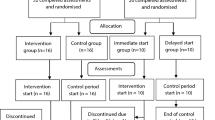Abstract
Levodopa (LD) application improves motor symptoms and reduces cortisol levels in patients with Parkinson’s disease (PD). Endurance exercise enhances cortisol release in proportion to the intensity of the effort and thus may counteract the LD associated cortisol decrease. We measured levels of cortisol and LD over an 1-h long interval following administration of soluble 200 mg LD/50 mg benserazide with concomitant maximal grip strength assessment in 16 PD patients under cued conditions during rest and endurance exercise. The motor response, the plasma levels of cortisol and LD did not significantly differ between both conditions. Cortisol concentrations significantly decreased even during exercise. Grip strength only significantly went up during rest. Endurance exercise did not counteract the LD associated decreased cortisol release. Since cortisol improves muscle function, the lack of increase in maximal grip strength following LD administration during exercise may contribute to reduced exercise capacity, which is reported by PD patients.




Similar content being viewed by others
References
Brandenberger G, Follenius M (1975) Influence of timing and intensity of musclar exercise on temporal patterns of plasma cortisol levels. J Clin Endocrinol Metab 40:845–849
Brandenberger G, Follenius M, Hietter B (1982) Feedback from meal-related peaks determines diurnal changes in cortisol response to exercise. J Clin Endocrinol Metab 54:592–596
Brown P, Corcos DM, Rothwell JC (1997) Does parkinsonian action tremor contribute to muscle weakness in Parkinson’s disease? Brain 120(Pt 3):401–408
Busa WB, Nuccitelli R (1984) Metabolic regulation via intracellular pH. Am J Physiol 246:R409–R438
Goetz CG, Thelen JA, MacLeod CM, Carvey PM, Bartley EA, Stebbins GT (1993) Blood levodopa levels and unified Parkinson’s disease rating scale function: with and without exercise. Neurology 43:1040–1042
Hoglund E, Kolm N, Winberg S (2001) Stress-induced changes in brain serotonergic activity, plasma cortisol and aggressive behavior in Arctic charr (Salvelinus alpinus) is counteracted by L-DOPA. Physiol Behav 74:381–389
Kanaley JA, Weltman JY, Pieper KS, Weltman A, Hartman ML (2001) Cortisol and growth hormone responses to exercise at different times of day. J Clin Endocrinol Metab 86:2881–2889
Kemmler W, Wildt L, Engelke K, Pintag R, Pavel M, Bracher B, Weineck J, Kalender W (2003) Acute hormonal responses of a high impact physical exercise session in early postmenopausal women. Eur J Appl Physiol 90:199–209
Kraemer WJ, Ratamess NA (2005) Hormonal responses and adaptations to resistance exercise and training. Sports Med 35:339–361
Loeffler DA, LeWitt PA, Juneau PL, Camp DM, DeMaggio AJ, Havaich MK, Milbury PE, Matson WR (1998) Influence of repeated levodopa administration on rabbit striatal serotonin metabolism, and comparison between striatal and CSF alterations. Neurochem Res 23:1521–1525
Lopez A, Munoz A, Guerra MJ, Labandeira-Garcia JL (2001) Mechanisms of the effects of exogenous levodopa on the dopamine-denervated striatum. Neuroscience 103:639–651
Lou JS, Kearns G, Benice T, Oken B, Sexton G, Nutt J (2003) Levodopa improves physical fatigue in Parkinson’s disease: a double-blind, placebo-controlled, crossover study. Mov Disord 18:1108–1114
Mannisto PT, Tuomainen P, Toivonen M, Tornwall M, Kaakkola S (1990) Effect of acute levodopa on brain catecholamines after selective MAO and COMT inhibition in male rats. J Neural Transm Park Dis Dement Sect 2:31–43
Melamed E, Hefti F, Pettibone DJ, Liebman J, Wurtman RJ (1981) Aromatic L-amino acid decarboxylase in rat corpus striatum: implications for action of L-dopa in parkinsonism. Neurology 31:651–655
Merkies IS, Schmitz PI, Samijn JP, Meche FG, Toyka KV, Van Doorn PA (2000) Assessing grip strength in healthy individuals and patients with immune-mediated polyneuropathies. Muscle Nerve 23:1393–1401
Muhlack S, Welnic J, Woitalla D, Müller T (2007) Exercise improves efficacy of levodopa in patients with Parkinson’s disease. Mov Disord 22:427–430
Müller T, Muhlack S (2007a) Acute levodopa intake and associated cortisol decrease in patients with Parkinson disease. Clin Neuropharmacol 30:101–106
Müller T, Welnic J, Muhlack S (2006) Acute levodopa administration reduces cortisol release in patients with Parkinson’s disease. J Neural Transm 114:347–350
Müller T, Welnic J, Woitalla D, Muhlack S (2007b) Endurance exercise modulates levodopa induced growth hormone release in patients with Parkinson’s disease. Neurosci Lett 422:119–122
Philippi H, Pohlenz J, Grimm W, Koffler T, Schonberger W (2000) Simultaneous stimulation of growth hormone, adrenocorticotropin and cortisol with L-dopa/L-carbidopa and propranolol in children of short stature. Acta Paediatr 89:442–446
Reuter I, Harder S, Engelhardt M, Baas H (2000) The effect of exercise on pharmacokinetics and pharmacodynamics of levodopa. Mov Disord 15:862–868
Riad M, Mogos M, Thangathurai D, Lumb PD (2002) Steroids. Curr Opin Crit Care 8:281–284
Sutton JR, Jones NL, Toews CJ (1981) Effect of pH on muscle glycolysis during exercise. Clin Sci (Lond) 61:331–338
Vizner B, Reiner Z, Sekso M (1983) Effect of L-dopa on growth hormone, glucose, insulin, and cortisol response in obese subjects. Exp Clin Endocrinol 81:41–48
Wenzelburger R, Zhang BR, Pohle S, Klebe S, Lorenz D, Herzog J, Wilms H, Deuschl G, Krack P (2002) Force overflow and levodopa-induced dyskinesias in Parkinson’s disease. Brain 125:871–879
Ziv I, Avraham M, Michaelov Y, Djaldetti R, Dressler R, Zoldan J, Melamed E (1998) Enhanced fatigue during motor performance in patients with Parkinson’s disease. Neurology 51:1583–1586
Acknowledgments
We thank Ulrike Beckmann, Marion Frickmann, Christa Kraushaar-Szesny, Tanja Steiner, Christiane Stamm for technical assistance. We thank the participating patients.
Author information
Authors and Affiliations
Corresponding author
Rights and permissions
About this article
Cite this article
Müller, T., Muhlack, S. Impact of endurance exercise on levodopa-associated cortisol release and force increase in patients with Parkinson’s disease. J Neural Transm 115, 851–855 (2008). https://doi.org/10.1007/s00702-008-0018-7
Received:
Accepted:
Published:
Issue Date:
DOI: https://doi.org/10.1007/s00702-008-0018-7




